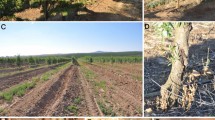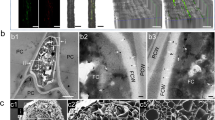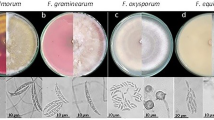Abstract
THE soil-borne fungus Fusarium oxysporum causes wilt in many economically important host plants and, like many plant pathogenic fungi, it consists of several specialized forms, each including a number of pathogenic races. A striking feature of Fusarium wilts is their sudden occurrence in crops in which they were previously unknown1,2. Such new disease outbreaks clearly suggest that either saprophytic forms of the fungus have become parasitic or that existing parasitic races have extended their host-range. Among genetic mechanisms already proposed to explain such changes of pathogenicity in Fusarium and other imperfect fungi are mutation, heterokaryosis, which allows haploid nuclei to associate in various ways, and a parasexual mechanism3, which allows permanent genetic recombination without a sexual stage4. On the other hand, there is some evidence that pathogenicity can be influenced by the host. For example, Reddick and Mills5 increased the varietal host range of Phytophthora infestans by successively transferring haploid zoospore cultures on to a series of potato varieties of increasing resistance to this fungus. Bawden6, in discussing the role of plant hosts in microbial ecology, pointed out that this approach can be extended by first correlating the mechanism of resistance with the presence in the host of some toxin specific to the fungus pathogen or with the lack of some metabolite essential for its growth.
This is a preview of subscription content, access via your institution
Access options
Subscribe to this journal
Receive 51 print issues and online access
$199.00 per year
only $3.90 per issue
Buy this article
- Purchase on Springer Link
- Instant access to full article PDF
Prices may be subject to local taxes which are calculated during checkout
Similar content being viewed by others
References
Weber, G. F., Plant Disease Rep., 41, 640 (1957).
Baldwin, B. J. T., Commonwealth Phytopathological News, 2, 25 (1956).
Pontecorvo, G., Roper, J. A., and Forbes, E., J. Gen. Microbiol, 8, 198 (1953).
Buxton, E. W., J. Gen. Microbiol., 15, 133 (1956).
Reddick, D., and Mills, W. R., Amer. Potato J., 15, 29 (1938).
Bawden, F. C., Symp. Soc. Gen. Microbiol., 7, 299 (1957).
Buxton, E. W., Trans. Brit. Mycol. Soc., 40, 145 (1957).
Dean, A. C. R., and Hinshelwood, C. N., Symp. Soc. Gen. Microbiol., 3, 21 (1953).
Stanier, R. Y., Ann. Rev. Microbiol., 5, 35 (1951).
Author information
Authors and Affiliations
Rights and permissions
About this article
Cite this article
BUXTON, E. A Change of Pathogenic Race in Fusarium oxysporum f. pisi induced by Root Exudate from a Resistant Host. Nature 181, 1222–1224 (1958). https://doi.org/10.1038/1811222b0
Issue Date:
DOI: https://doi.org/10.1038/1811222b0
This article is cited by
-
Soil pathogen, Fusarium oxysporum induced wilt disease in chickpea: a review on its dynamicity and possible control strategies
Proceedings of the Indian National Science Academy (2021)
-
Analysis of SDS-dissociated proteins of pathogenic and nonpathogenicFusarium species
Mycopathologia (1994)
-
Biological antagonisms due to phytotoxic root exudates
The Botanical Review (1960)
Comments
By submitting a comment you agree to abide by our Terms and Community Guidelines. If you find something abusive or that does not comply with our terms or guidelines please flag it as inappropriate.



